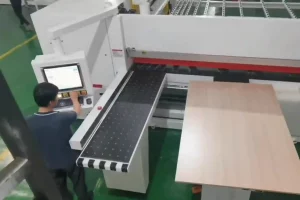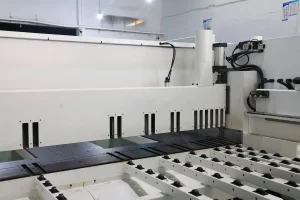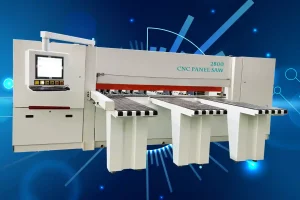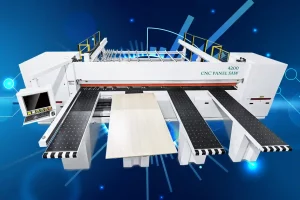
Troubleshooting Common Issues with Automatic Computer Panel Saws
Automatic Computer Panel Saws play a vital role in modern manufacturing and fabrication processes, offering efficiency and precision in cutting large sheets of material. While these machines are highly reliable, they can occasionally encounter issues that disrupt production. Understanding and addressing these common problems is crucial to ensure optimal performance and minimize downtime.
Addressing Feed Motor Problems in Automatic Computer Panel Saws
One prevalent issue with Automatic Computer Panel Saws is feed motor problems. Over time, feed motors can experience wear and tear, leading to reduced power and inconsistent feed speeds. This can result in uneven cuts and damage to the saw blade. Regular inspection and replacement of worn motor components are essential to prevent such problems.
Feed motors drive the material through the saw at a consistent speed, ensuring smooth and accurate cuts. When the motor’s performance declines, it can cause the material to feed unevenly, leading to jagged or incomplete cuts. This not only affects the quality of the finished product but can also increase the wear on the saw blade and other components.
In conclusion, addressing feed motor problems in Automatic Computer Panel Saws is crucial for maintaining high-quality cuts and extending the machine’s lifespan. Regular maintenance, including the inspection and replacement of worn components, can prevent these issues and ensure consistent performance. By keeping the feed motor in optimal condition, you can reduce downtime and improve overall productivity in your manufacturing process.
Tackling Electrical Issues in Automatic Computer Panel Saws
Electrical issues can also pose significant challenges for Automatic Computer Panel Saws. Power fluctuations, faulty wiring, or loose connections can disrupt the saw’s electrical system. Symptoms include erratic blade movement, inconsistent cutting depths, and even complete machine shutdown. Thorough electrical inspection and troubleshooting by a qualified technician are necessary to identify and resolve these issues.
The electrical system of an Automatic Computer Panel Saw is complex and requires regular monitoring to ensure it operates correctly. Any disruption in the electrical supply can lead to significant problems, affecting the machine’s ability to perform precise cuts. Identifying the root cause of electrical issues can be challenging, but it is essential for maintaining the machine’s reliability.
Conclusion on Electrical Issues
In conclusion, tackling electrical issues in Automatic Computer Panel Saws requires diligent inspection and troubleshooting. Ensuring that the electrical components are in good condition and addressing any faults promptly can prevent disruptions in the cutting process. By maintaining a stable electrical system, you can achieve consistent and accurate cuts, thereby enhancing the overall efficiency of your manufacturing operations.
Ensuring Proper Blade Alignment in Automatic Computer Panel Saws
Blade alignment problems can lead to inaccurate cuts and reduced material yield in Automatic Computer Panel Saws. Improper blade alignment can cause the blade to bind or wander during operation, resulting in poor cut quality. Regular blade alignment checks and adjustments are vital to ensure precise cuts.
The blade’s alignment is critical to the accuracy of the cuts made by the saw. If the blade is not properly aligned, it can deviate from the intended cutting path, leading to errors in the dimensions of the cut pieces. This not only wastes material but also requires additional time and effort to correct the mistakes.
Conclusion on Blade Alignment
In conclusion, ensuring proper blade alignment in Automatic Computer Panel Saws is essential for achieving high-quality cuts. Regular alignment checks and timely adjustments can prevent misalignment issues, ensuring that the blade follows the correct cutting path. By maintaining proper blade alignment, you can improve material yield, reduce waste, and enhance the overall efficiency of your cutting operations.
Managing Sensor Malfunctions in Automatic Computer Panel Saws
Sensor malfunctioning can disrupt the functionality of Automatic Computer Panel Saws. Sensors play a crucial role in detecting material thickness and blade position. Faulty sensors can lead to inaccurate cuts and damage to both the saw and the material. Thorough sensor testing and replacement of malfunctioning sensors are essential.
Sensors are integral to the automated operations of these saws, providing real-time data that guides the cutting process. When sensors fail, the saw may not receive accurate information, leading to errors in the cutting process. This can result in cuts that are too deep, too shallow, or improperly positioned, compromising the quality of the finished product.
Conclusion on Sensor Malfunctions
In conclusion, managing sensor malfunctions in Automatic Computer Panel Saws is critical for maintaining precision and reliability. Regular sensor testing and prompt replacement of faulty sensors can ensure that the saw operates accurately and efficiently. By addressing sensor issues, you can prevent costly mistakes and maintain the high standards of your manufacturing process.
Handling Hydraulic Problems in Automatic Computer Panel Saws
Hydraulic problems can affect the saw’s ability to move and position materials accurately. Low fluid levels, air bubbles, or faulty hydraulic components can lead to instability and reduced efficiency. Regular inspection and maintenance of the saw’s hydraulic system are crucial to prevent these issues.
The hydraulic system in an Automatic Computer Panel Saw provides the necessary force to move heavy materials and maintain precise positioning during the cutting process. Any problems within this system can result in delays, inaccuracies, and potential damage to the materials or the saw itself. Ensuring that the hydraulic components are functioning correctly is vital for smooth operations.
Conclusion on Hydraulic Problems
In conclusion, handling hydraulic problems in Automatic Computer Panel Saws involves regular maintenance and prompt attention to any issues. By keeping the hydraulic system in good condition, you can ensure stable and efficient operation, minimizing downtime and enhancing productivity. Addressing hydraulic issues proactively helps maintain the overall performance and reliability of the saw.
Resolving Software Problems in Automatic Computer Panel Saws
Software problems can also contribute to issues with Automatic Computer Panel Saws. Outdated software, corrupted files, or improper settings can lead to control issues and inaccurate cuts. Updating the saw’s software to the latest version and ensuring proper settings are essential to resolve these problems.
The software that controls an Automatic Computer Panel Saw is responsible for executing precise cutting instructions and managing the machine’s operations. Any glitches or outdated software can lead to significant disruptions in the cutting process. Regular updates and proper configuration are necessary to maintain optimal performance.
Conclusion on Software Problems
In conclusion, resolving software problems in Automatic Computer Panel Saws is crucial for maintaining accurate and efficient operations. Keeping the software up-to-date and ensuring that all settings are correctly configured can prevent many common issues. By addressing software problems promptly, you can ensure that your saw continues to perform at its best, providing reliable and precise cuts.
Automatic Computer Panel Saws are essential tools in modern manufacturing, but they can encounter various issues that disrupt their performance. By addressing common problems such as feed motor issues, electrical problems, blade alignment, sensor malfunctions, hydraulic troubles, and software glitches, you can ensure that your saw operates efficiently and reliably. Regular maintenance, thorough inspections, and prompt troubleshooting are key to minimizing downtime and maintaining high-quality cuts.
FAQ
Q: What are common feed motor problems in Automatic Computer Panel Saws?
A: Common feed motor problems include reduced power and inconsistent feed speeds, which can result in uneven cuts and damage to the saw blade.
Q: How can electrical issues affect Automatic Computer Panel Saws?
A: Electrical issues such as power fluctuations, faulty wiring, or loose connections can cause erratic blade movement, inconsistent cutting depths, and even complete machine shutdown.
Q: Why is blade alignment important in Automatic Computer Panel Saws?
A: Proper blade alignment is essential for accurate cuts. Misaligned blades can cause binding or wandering during operation, leading to poor cut quality and reduced material yield.
Q: What role do sensors play in Automatic Computer Panel Saws?
A: Sensors detect material thickness and blade position, providing crucial data for precise cuts. Malfunctioning sensors can lead to inaccurate cuts and potential damage to the saw and material.
Q: How can hydraulic problems impact the performance of Automatic Computer Panel Saws?
A: Hydraulic problems, such as low fluid levels or faulty components, can affect the saw’s ability to move and position materials accurately, leading to instability and reduced efficiency.
Q: What are common software problems in Automatic Computer Panel Saws?
A: Common software problems include outdated software, corrupted files, and improper settings, which can lead to control issues and inaccurate cuts.
By understanding and addressing these common issues, businesses can ensure the optimal performance of their Automatic Computer Panel Saws, enhancing productivity and achieving high-quality results.





































